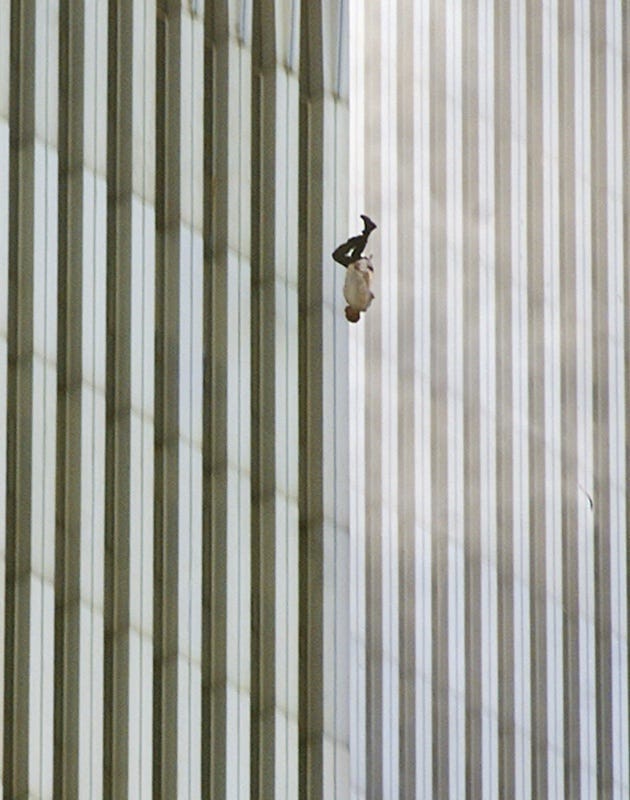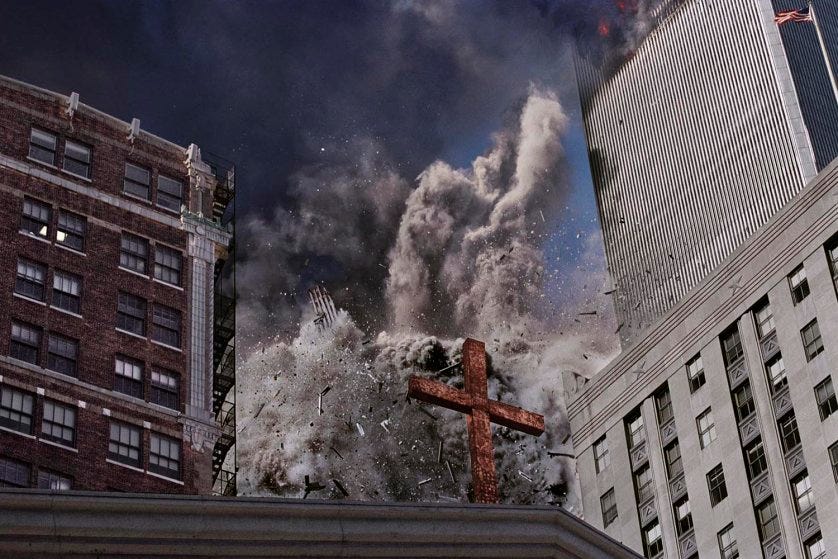Eighteen years is a long time. It’s all grown up now; this tragedy is old enough to vote.
It’s striking how the little things stand out in my memory of that day. And how the big things elude me. I can’t remember if it was in first period that I learned of it, or if it was second. I seem to remember it being chattered about during the class switch, but I can’t be sure. I can’t remember if Mrs. Day was watching on a TV or on her computer. I can’t remember if I saw the towers come down in real-time, or which of the hundreds of loops of that footage I first saw with my own eyes.
I do remember football practice that afternoon. I remember a coach telling us gasoline in Memphis had skyrocketed in price. I remember going home to find my uncle there. He was divorced and spent many evenings visiting his extended family, likely just seeking to alleviate the loneliness. These visits were frequent and underappreciated. In just a few years, we’d lose him to suicide, and it’s doubly painful to have that day as one of the most easily recalled memories of him. We ate pizza and watched TV. Planes crashing. Towers falling. Survivors running, bleeding, covered in dust, crying. Over and over again.
For those my age, we’ve grown up alongside this tragedy. We scarcely remember life before it. Sometimes, we scarcely remember it. But today is not that day. Today, we remember.
GREAT WRITING
Any excuse to share Tom Junod’s The Falling Man should not be passed up. It’s the quest to discover who the man in the photograph is and why we as a country refused to look at it, and it’s been called one of the best magazine stories of all-time.

Richard Drew/AP
The opening lines:
In the picture, he departs from this earth like an arrow. Although he has not chosen his fate, he appears to have, in his last instants of life, embraced it. If he were not falling, he might very well be flying. He appears relaxed, hurtling through the air. He appears comfortable in the grip of unimaginable motion. He does not appear intimidated by gravity's divine suction or by what awaits him.
The idea for the story is novel: an entire magazine story centered around a photograph. It was a taboo photograph though, depicting one of the darkest days our country has ever known. But the story works its magic by striving to remove the stigma. Read it. Re-read it. Remember.
- Extra Credit: Listen to Junod discuss the reporting and writing of this piece on the Esquire Classic podcast.
I remember the cover of Time magazine that ran after 9/11. We still subscribed to it at the time, and I remember the writing inside only in bits. But a writer instructor of mine worked at Time, and he had us revisit Nancy Gibbs’ piece from that issue. It’s breathtaking writing. In the first paragraph, she writes:
If you want to humble an empire it makes sense to maim its cathedrals. They are symbols of its faith, and when they crumple and burn, it tells us we are not so powerful and we can't be safe. The Twin Towers of the World Trade Center, planted at the base of Manhattan island with the Statue of Liberty as their sentry, and the Pentagon, a squat, concrete fort on the banks of the Potomac, are the sanctuaries of money and power that our enemies may imagine define us. But that assumes our faith rests on what we can buy and build, and that has never been America's true God.
Many of us may remember the footage of President Bush being told of the attacks. He was reading to schoolchildren. But how many of us remember what happened to him after that? Perhaps we forgot. Perhaps we never knew. Perhaps it never quite made sense to us, even if we heard it, but it’s true: He was in the air, on Air Force One. Garrett Graff wrote an oral history of those eight hours from the mouths of those on board the plane; you can read it here. And you should.
For the next eight hours, with American airspace completely cleared of jets, a single blue-and-white Boeing 747, tail number 29000—filled with about 65 passengers, crew and press, and the 43rd president, George W. Bush, as well as 70 box lunches and 25 pounds of bananas—traversed the eastern United States. On board, President Bush and his aides argued about two competing interests—the need to return to Washington and reassure a nation and the competing need to protect the commander in chief. All the while, he and his staff grappled with the aftermath of the worst attack on American soil in their lifetimes, making crucial decisions with only flickering information about the attacks unfolding below. Bush struggled even to contact his family and to reach Vice President Dick Cheney in the White House bunker.
POWERFUL IMAGES
Junod’s piece hinges on a photograph. What could be an entire story all to itself (and is relegated to a single section in Junod’s piece) is the story of the man who shot the photograph. His name is Richard Drew, and he’d photographed history before. He was there the night Bobby Kennedy was assassinated. He got more than just photographs of that night; he’s got a jacket with Kennedy’s blood dried into it. Drew wasn’t the only famous photographer who happened to be on the scene on 9/11. James Nachtwey’s photographs ran in Time magazine, and they capture the chaos and terror of that day.

James Nachtwey/Time
INSPIRATION
As if the universe cared about baseball, America’s game, it felt right, almost cosmically so, that so soon after the darkness of the attacks that Tuesday morning, the New York Yankees would be playing in the World Series. For Game 3, President Bush was to throw out the ceremonial first pitch. In New York. In the House that Ruth Built. Just a month removed from the attacks. It doesn’t take a baseball purist or a Beltway insider to understand the magnitude of the optics of that moment. It doesn’t take a former pitcher, who’s thrown a ball from 60 feet, 6 inches so many times as to have lost count, to appreciate how nerve-racking that can be. It seemed the universe cared about America, as President Bush wasted no time in getting to the ready and delivering a perfect pitch, complete with a slight tailing action, right down the middle. Except for his stepping on the chalk on his way out to the mound, everything he did was perfect. (Stepping on the chalk is a no-no in the superstitious world of baseball. Bush owned the Texas Rangers, so surely he knew that. I mean, he could have jinxed the whole damn thing right there.) If you’ve got just a minute, watch this clip of that pitch, try to transport yourself to that time and that place, and what it would have felt like to see your president do something so simple yet so profound.
Gets me every time. If you’ve got half an hour, watch this brilliant ESPN 30 for 30 short film about that pitch.
REDEMPTION
Most would pause to consider whether blood lust was socially acceptable in 2011. Most would likely say no. But on May 1, 2011, those of us old enough to remember the attacks of ten years prior gave into it. Even if only for just a second. Even if we weren’t proud of ourselves afterwards, we were so happy in that moment when President Obama announced the search for bin Laden was over. I remember the news networks scrambling. I remember the speculation about what news the president would share at 11:35 p.m. I remember thinking it was big. I remember sitting on my couch, in a one-bedroom apartment in Knoxville, Tennessee, and fist-pumping when the news rolled in. Here’s the video from that night, and if you think about it, those 10 minutes might be the last genuinely non-partisan moment we’ve seen in America.
Not even national tragedies like the countless, pointless mass shootings are viewed as non-partisan moments, not even when the victims are elementary school students. But in this moment, there were no red states, there were no blue states; it took the death of the man who effectively tore us apart to bring us back together, if only for just a second.
We longed to know the details; we longed to know the story: What happened on the raid that killed bin Laden? The blood lust in us found it unfair that only the small teams of elite Navy SEALs know the true story. It was harrowing, and terrible in its own way, but Phil Bronstein captured the story with a reporter’s rigor. It’s well worth your time to read today, 18 years after this outcome was set in motion.
- Extra Credit: Listen to Bronstein discuss the reporting and writing of the piece on the Esquire Classic podcast.
Before 9/11, before the 10-year manhunt, we had an inkling of what bin Laden was, because John Miller interviewed him for ABC News in 1998. Miller then wrote about the experience for Esquire. I remember learning this first-hand from Miller as he spoke to a group of students who were studying in Washington, D.C. in 2008. Just think: At that time, the interview was 10 years old, the attacks were seven years old and I’d been clicking around the internet for at least that long, but I never knew about it. Did you?
One last factoid for the “bin Laden” portion of this newsletter: Does anyone remember how Dwayne “The Rock” Johnson all but broke the news of the raid some nine hours before President Obama spoke? Because that happened. (The most persistent explanation, though never confirmed by Johnson himself, is that he got word of the raid from his cousin, who was a Navy SEAL at the time.)
18 YEARS LATER
The effects are still felt today. Not just by those of us who remember because of an anniversary. For some, the anniversary is personal. Too personal. Much too personal when one considers how relatively infrequently the rest of us think about their plight. This doesn’t only extend to those killed in the attacks, or those that lost loved ones in the attacks, as their pain was absolute and immediate and every day since has been a slow, much too slow, recovery process. No, there are fellow Americans—New Yorkers, to be exact—suffering from sickness and cancer caused by the conditions at Ground Zero that day. In June, Jon Stewart, former host of The Daily Show, went to Capitol Hill to advocate for the September 11th Victims Compensation Fund, a bill that would provide for medical expenses incurred by New York’s first responders, to be reauthorized until 2090. He gave an unforgettable, deeply patriotic speech, and a month later, the bill was finally passed.
I can think of no better way to honor the memory of September 11th than to watch it, fully remembering the gravity of what was taken from us that day, the lengths to which some went to save us, the hope for doing right by them. It’s fitting that this particular video takes 9 minutes, 11 seconds.

Comments